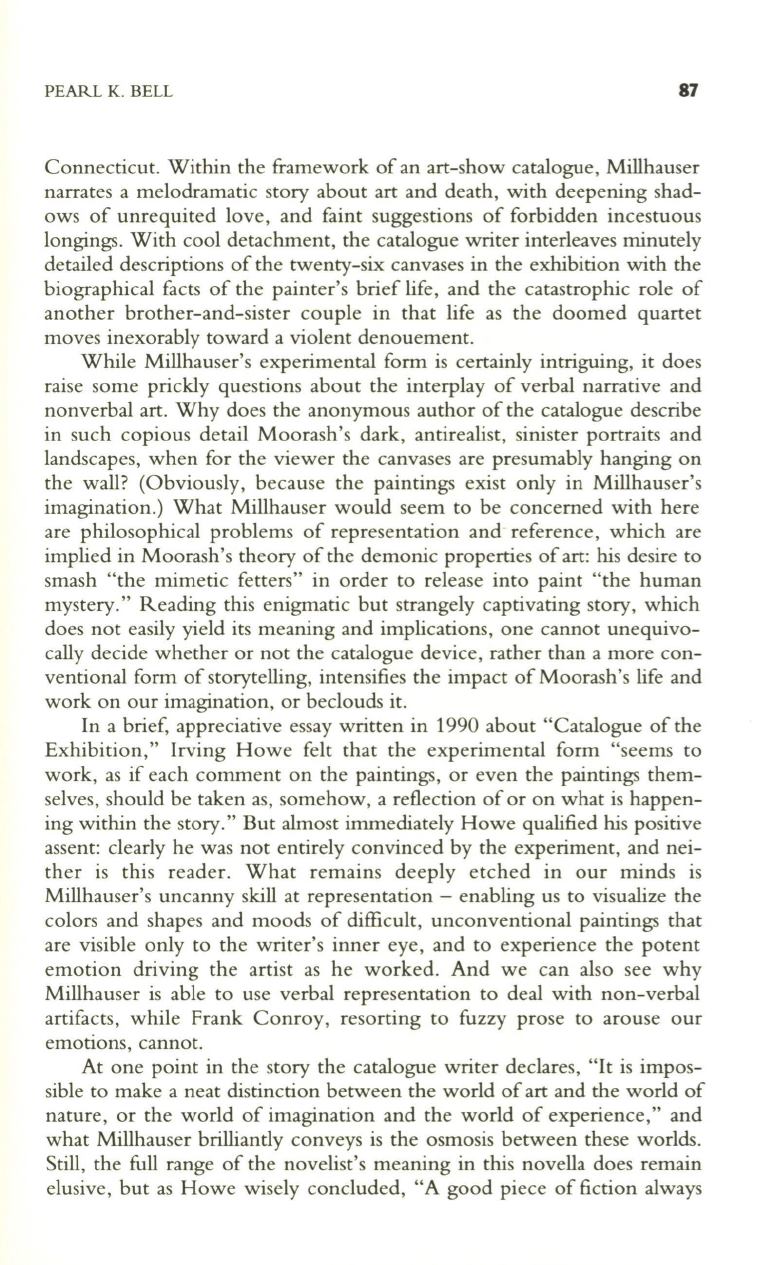
PEARL
K.
BELL
87
Connecticut. Within the framework of an art-show catalogue, Millhauser
narrates a melodramatic story about art and death, with deepening shad–
ows of unrequited love, and faint suggestions of forbidden incestuous
longings. With cool detachment, the catalogue writer interleaves minutely
detailed descriptions of the twenty-six canvases in the exhibition with the
biographical facts of the painter's brief life, and the catastrophic role of
another brother-and-sister couple in that life as the doomed quartet
moves inexorably toward a violent denouement.
While Millhauser's experimental form is certainly intriguing, it does
raise some prickly questions about the interplay of verbal narrative and
nonverbal art. Why does the anonymous author of the catalogue describe
in such copious detail Moorash's dark, antirealist, sinister portraits and
landscapes, when for the viewer the canvases are presumably hanging on
the wall? (Obviously, because the paintings exist only in Millhauser's
imagination.) What Millhauser would seem to be concerned with here
are philosophical problems of representation and· reference, which are
implied in Moorash's theory of the demonic properties of art: his desire to
smash "the mimetic fetters" in order to release into paint "the human
mystery." Reading this enigmatic but strangely captivating story, which
does not easily yield its meaning and implications, one cannot unequivo–
cally decide whether or not the catalogue device, rather than a more con–
ventional form of storytelling, intensifies the impact of Moorash's life and
work on our imagination, or beclouds it.
In a brief, appreciative essay written in 1990 about "Catalogue of the
Exhibition," Irving Howe felt that the experimental form "seems to
work, as if each comment on the paintings, or even the paintings them–
selves, should be taken as, somehow, a reflection of or on what is happen–
ing within the story." But almost immediately Howe qualified his positive
assent: clearly he was not entirely convinced by the experiment, and nei–
ther is this reader. What remains deeply etched in our minds is
Millhauser's uncanny skill at representation - enabling us to visualize the
colors and shapes and moods of difficult, unconventional paintings that
are visible only to the writer's inner eye, and to experience the potent
emotion driving the artist as he worked. And we can also see why
Millhauser is able to use verbal representation to deal with non-verbal
artifacts, while Frank Conroy, resorting to fuzzy prose to arouse our
emotions, cannot.
At one point in the story the catalogue writer declares,
"It
is impos–
sible to make a neat distinction between the world of art and the world of
nature, or the world of imagination and the world of experience," and
what Millhauser brilliantly conveys is the osmosis between these worlds.
Still, the full range of the novelist's meaning in this novella does remain
elusive, but as Howe wisely concluded, "A good piece of fiction always


